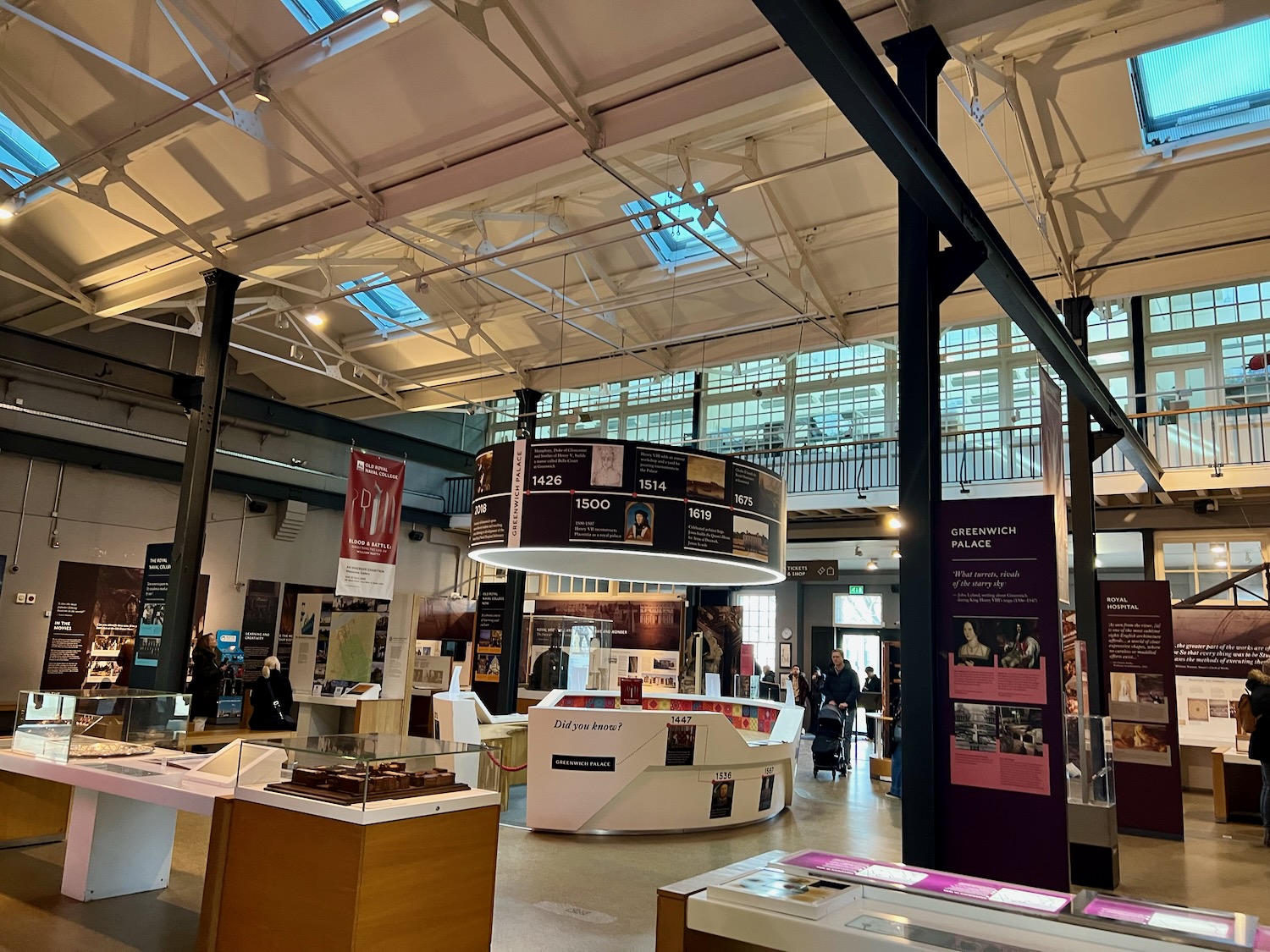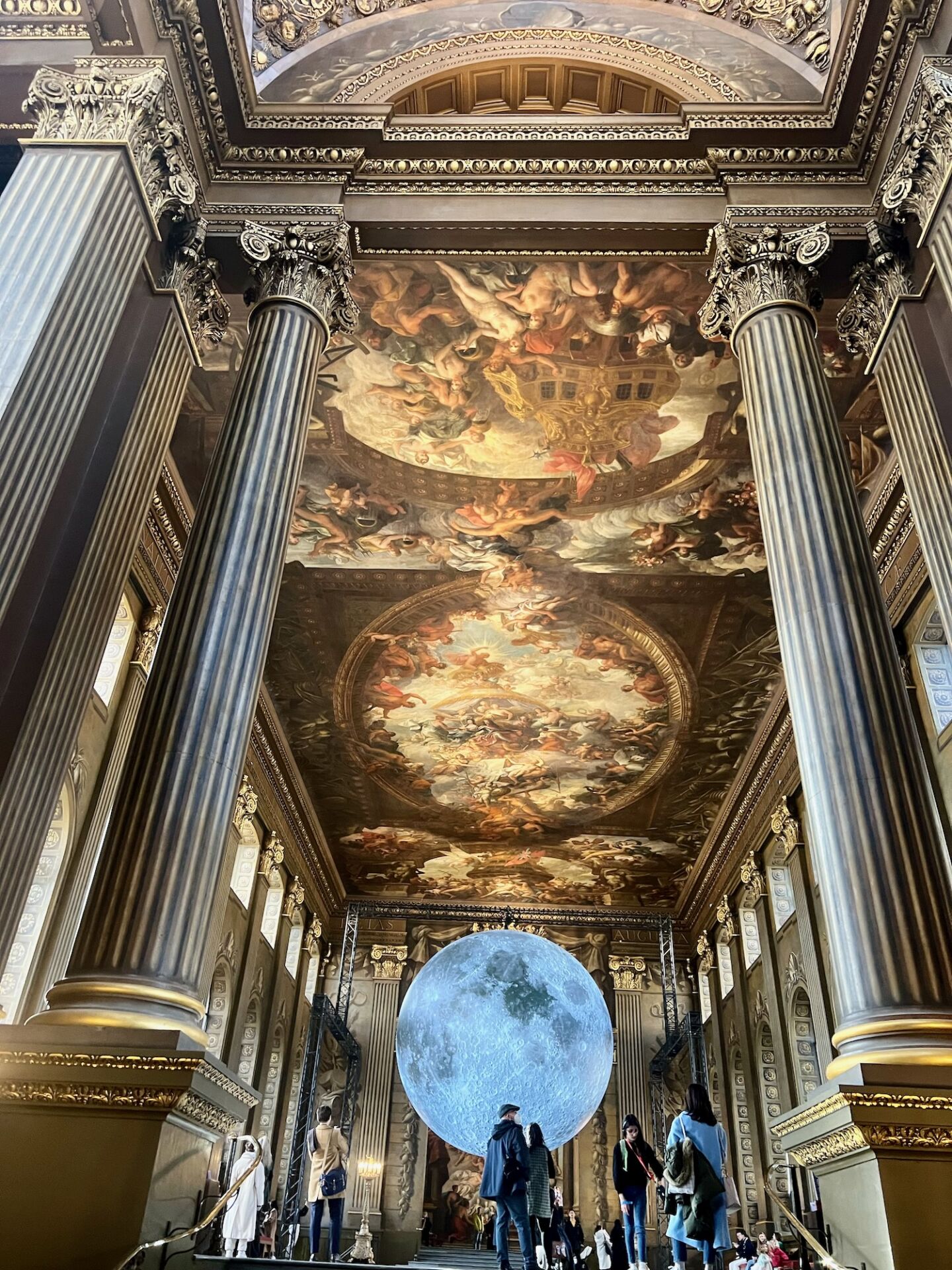This year is a very good time to visit the spectacular Old Royal Naval College (ORNC), right in the heart of Greenwich, especially if you love royal and maritime history and architecture. In 2023 we are celebrating Wren 300. This is a commemoration of 300 years since the death of the great architect of the ORNC, Sir Christopher Wren, who gave his time for free when the building was commissioned in 1694. So what is the ORNC, and why should you include it on a visit to London?
If you’ve enjoyed the major sites in central London, then there’s nothing better than getting a Thames Clipper river bus six miles along the River Thames to Greenwich. You disembark to be greeted by the elegant 19th century Cutty Sark sailing ship now sitting in dry dock and definitely worth a visit to explore its famous history.
 Cutty Sark in Greenwich. Photo Credit: © Ursula Petula Barzey.
Cutty Sark in Greenwich. Photo Credit: © Ursula Petula Barzey.
The Lost Palace of Greenwich
Take a look inside the Greenwich Visitor Centre. As well as the shop and friendly staff, you will find many objects on display, including a model of the now-lost royal palace of Greenwich. This is the birthplace of some of the most famous monarchs in British history: Henry VIII, (Bloody) Mary I, and Elizabeth I. The old red brick Tudor palace fell into a dilapidated state during the time of the English Civil War in the 1640s, but it was following the return of the monarchy in the figure of King Charles II in 1660 that a new reincarnation of the site started to appear on the bend in the great river.
 Greenwich Visitor Centre in London. Photo Credit: © Ursula Petula Barzey.
Greenwich Visitor Centre in London. Photo Credit: © Ursula Petula Barzey.
A New Royal Palace becomes a Royal Hospital
The king wanted to create a new palace inspired by his time in exile in France. It would be a new Versailles. The 17th-century diarist Samuel Pepys noted on 4 March 1664 “…at Greenwich did observe the foundacion laying of a very great house for the King, which will cost a great deal of money.”
The king indeed ran out of money and interest, and we were left with one completed wing, the white Portland stone of the King Charles wing, which can be seen on your right with your back to the river. You can still see his coat of arms in the central triangular pediment above the columns and the figure of Fortitude to the left, and Dominium of the Sea to the right.
The building remained largely unused until the site was granted for use as a Royal Naval Hospital in 1694. It was the brainchild of Charles’s niece Queen Mary II who wanted to offer a place of sanctuary to British naval veterans along the lines of the home for army veterans back up the river in Chelsea, west London. Three more courts were added following the design of Sir Christopher Wren and his apprentice Nicolas Hawksmoor and the complex has become one of the best examples of Baroque architecture in Britain. It took 55 years to complete and, at its peak housed more than 2,700 naval veterans.
 Old Royal Naval College in Greenwich. Photo Credit: © Ursula Petula Barzey.
Old Royal Naval College in Greenwich. Photo Credit: © Ursula Petula Barzey.
The Painted Hall – A Hidden Gem
You have to imagine the grandeur of this site that greeted foreign dignitaries arriving by the river to meet the king or queen of the day further upriver in central London. The Royal Naval Hospital was so much more than a home for retired or injured sailors, it was architectural propaganda showing off the might of the Protestant British monarchy and the Royal Navy.
To see the ultimate in this exuberance, you really must visit the hidden gem of the ORNC, which is the Painted Hall, the magnificent dining room initially built for the old sailors. The hall, painted by Sir James Thornhill, has been described as the Sistine Chapel of Britain.
If you have visited St Paul’s Cathedral, then you have already seen Thornhill’s work inside the dome of another of Wren’s masterpieces. Come and lie on one of the comfortable seats and stare up at a masterpiece of figure painting, symbolism, and allegory. In the centre of the lower chamber, you will see Protestant Queen Mary II and her husband, King William III, who has his foot on the head of the Catholic French King Louis XIV. On the back wall of the Upper Chamber, look for the figure of the artist himself, James Thornhill, in the bottom right-hand corner with his hand held out. Can you see the ghost hand at the bottom of the trompe-l’œil stairs? Thornhill had to adjust his designs as monarchs and dynasties came and went, so make sure you look for royalty across the ceiling and walls in both chambers.
 Museum of the Moon at the Painted Hall. Photo Credit: © Ursula Petula Barzey.
Museum of the Moon at the Painted Hall. Photo Credit: © Ursula Petula Barzey.
Arrival of Admiral Nelson
It was here in the Painted Hall in the dark of night on Christmas Day 1805 that the body of Admiral Nelson was temporarily laid to rest following its journey after the Battle of Trafalgar in southern Spain, where he was shot dead by a sniper. Nelson is buried in the crypt of St Paul’s Cathedral, but you will find the newly renovated Nelson Room adjacent to the Upper Chamber, which tells the story of Nelson’s life and his connection to Greenwich.
For another hidden gem, find the story of Nelson’s death as depicted in a second triangular-shaped pediment. Pass through the right-hand colonnade with your back to the river. Descend the steps into what looks like an empty courtyard and immediately turn around and look up. Here we see Nelson cradled up to heaven by angels and the goddess Athena or is this the Brittania who rules the waves? The American artist, Benjamin West, was clearly inspired by the Parthenon Marbles, which had arrived from Athens to London’s British Museum only a few years before West completed his Nelson story in 1812. It even has horses like the ones in the original ancient Greek version.
 Statue of Admiral Lord Nelson in the Painted Hall. Photo Credit: © Ursula Petula Barzey.
Statue of Admiral Lord Nelson in the Painted Hall. Photo Credit: © Ursula Petula Barzey.
A Royal Naval Hospital becomes a Royal Naval College
There was a constant battle to source funding for the hospital. The 1735 Rysbrack statue of King George II, located in the centre of the lower open area, is a thank-you gesture to the king. Proceeds had been donated to the hospital from the sale of the estates of Lord Derwentwater, who had been beheaded for treason.
By 1869, it was time for another reincarnation of the site. It was eventually deemed unnecessary for naval pensioners to be cared for in one place, and so the Royal Naval Hospital became the Royal Naval College or a university for naval officers. The site suited the dignified image of the Senior Service, spacious and historical.
The cabins that had housed the old sailors were turned into bedrooms fit for officers. Lecture theatres and classrooms for teaching all the subjects needed to train the future commanders of the British Royal Navy were built within the still elegant shell of the four royal courts. The magnificent Painted Hall was now the grand dining room of naval officers as well as a gallery of naval paintings, many of which can be seen across the road in the elegant Queen’s House or the fascinating National Maritime Museum, both of which are free to visit.
In 1939 the first women were admitted to the Royal Navy and underwent training here. In the 1960s, a low-power nuclear reactor was installed as part of the Polaris missile training programme. It hardly generated enough electricity to boil a kettle, yet cost £1m to decommission in the 1990s when the site faced its next reincarnation.
 View of the Greenwich Park, Old Royal Naval College and Canary Wharf from the Royal Observatory Greenwich. Photo Credit: © Ursula Petula Barzey.
View of the Greenwich Park, Old Royal Naval College and Canary Wharf from the Royal Observatory Greenwich. Photo Credit: © Ursula Petula Barzey.
A New Kind of Academic Institution
In 1995, the British government decided to unite all UK Armed Forces training into one location at the Defence Academy in Swindon, southwest England. The naval officers finally moved out. They were replaced by students of the University of Greenwich and Trinity Laban Conservatoire of Music and Dance, which established a new campus here across three of the four royal courts. You might catch the students having their graduation photos taken with the magnificent Wren building as a backdrop.
 University of Greenwich sign. Photo Credit: © Ursula Petula Barzey.
University of Greenwich sign. Photo Credit: © Ursula Petula Barzey.
Lights, Cameras, Action!
If you haven’t yet been to the Old Royal Naval College, you may have seen it without realising it, as this is a much-used film and TV location. Here are just some examples where you might spot Wren’s colonnade or his twin domes or the brick and stone of the William Court on the screen: Four Weddings and a Funeral, Les Miserables, Darkest Hour, Gulliver’s Travels, Thor The Dark World, The Iron Lady and The Crown. Go inside the open courtyard of the Charles Court AKA Trinity Laban Conservatoire. You will probably hear music but also look for a drainpipe in the northern corner. This was the drainpipe used in the making of Netflix’s The Crown when Michael Fagan gets into Queen Elizabeth II’s bedroom in 1982.
 Nine films and one television series have been shot at the Old Royal Naval College in Greenwich. Photo Credit: © Ursula Petula Barzey.
Nine films and one television series have been shot at the Old Royal Naval College in Greenwich. Photo Credit: © Ursula Petula Barzey.
Eating and Drinking in Greenwich
You can get great street food at the Market in the centre of town. The market still belongs to the same charity set up by Queen Mary II in 1694. There are also many pubs, including the riverside Trafalgar Tavern just next to the ORNC. Built-in 1837, this is where Charles Dickens came to eat the small Whitebait fish on his return from his first US tour.
Make Travelling to Greenwich part of the Adventure
You can reach Greenwich Pier from Central London by the Thames Clipper river bus. This takes about 20 – 40 minutes, or even quicker is the train from Charing Cross or London Bridge station. Alternatively, why not try the driverless trains of the Docklands Light Railway? I recommend getting off at Island Gardens to access the amazing Canaletto view of the ORNC, then walking under the Thames River via the Greenwich Foot Tunnel.
 Entrance to Greenwich Foot Tunnel. Photo Credit: © Ursula Petula Barzey.
Entrance to Greenwich Foot Tunnel. Photo Credit: © Ursula Petula Barzey.
 Greenwich Foot Tunnel. Photo Credit: © Ursula Petula Barzey.
Greenwich Foot Tunnel. Photo Credit: © Ursula Petula Barzey.







Leave a Reply